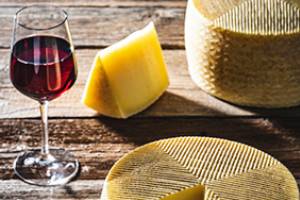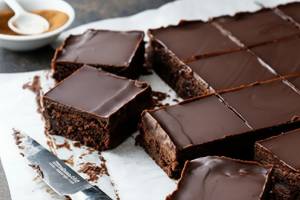|
For a connoisseur of fine chocolate and fine cheese, this is an offering you won’t find anywhere else*: the Fromage Chocolate Collection from M. Cacao, which pairs artisanal cheeses with gourmet chocolate for a luxurious and memorable tasting experience.
It’s something super-special for the chocolate connoisseur, for Valentine’s Day or any other occasion. And it’s our Top Pick Of The Week (maybe of the year!).
M. Cacao is an artisan chocolatier based in Amesbury, Massachusetts, acclaimed for its innovative approach to chocolate-making. They craft unique flavors and textures, blending classic French techniques with modern artistic flair.
What inspired this rare experience of curated chocolate-and-cheese combinations, both classic and surprising?
> We describe each piece in detail below, but first, some notes about why chocolate and cheese pair so well.
> Also below: how to serve chocolate and cheese as a dessert course.
WHY DO CHEESE & CHOCOLATE PAIR BEAUTIFULLY?
Cheese and chocolate share complementary textures, flavors, and fundamental chemical properties that enhance each other. The science creates the deliciousness, specifically:
The balance of sweet and savory. Cheese is naturally salty and umami-rich, while chocolate brings sweetness and sometimes bitterness. This contrast creates a dynamic taste experience, much like how salted caramel works.
The flavor synergy of fat and creaminess. Both cheese and chocolate are rich in fats, which contribute to a smooth, velvety mouthfeel. In the case of bittersweet chocolate, the creaminess of cheese can soften the intensity of the natural bitter compounds.
Complementary flavor compounds. Aged cheeses develop nutty and caramel-like flavors that match well with the notes of roasted cacao.
Almost all of the cheeses in the Fromage Chocolate Collection are aged: Cheddar, Comté, Gouda, Gruyère, Parmigiano Reggiano, Pecorino al Tartufo, and Roquefort.
Fresh cheeses, like the goat cheese piece, have a mild and milky profile that balances the sweetness of milk chocolate. Mascarpone and ricotta are also beautiful pairings with chocolate (or blonde/golden/dulcey chocolate—photo #5 and #7).
Pungent cheeses like the Roquefort in the collection contrast beautifully with dark chocolate,. The sharp and earthy notes play off the bitterness of high-cacao-content chocolate.
Acidity and contrast. Some cheeses have a tangy acidity that cuts through the richness of chocolate, preventing the pairing from feeling too heavy. Examples include chevre, feta, ricotta salata, and aged cheeses such as Camembert and Taleggio.
The contrast of textures. Smooth, creamy chocolate melts in the mouth. Aged cheeses have a crumbly or firm bite, while creamy cheeses like Brie blend seamlessly with melted or soft chocolate.
GET YOUR M.CACAO CHOCOLATES
Read the details of each of the eight precious pieces below. But we didn’t want shopping information to get lost in the shuffle, so here’s where you can…
Head to M.Cacao.com to look at the Fromage Chocolate Collection choices, which include:
16 piece box (2 of each bonbon flavor)
8 piece box (1 of each bonbon flavor)
Either box with your custom video greeting (photo #8)
Additionally, M. Cacao offers the Chef’s Collection, an assortment of handcrafted chocolates that narrate the stories of their chefs through both classic and innovative flavors.
Another favorite of ours: Chile Caramels, which will be our Top Pick next week.
There’s also a seasonal special, Hearts & Roses, a box of chocolate-enrobed pieces with beautiful hearts filled with Champagne ganache and square Rose Caramels, accented with a piece of rose petal.
THE CHOCOLATE-CHEESE FLAVORS
While some pairings sound unusual, they all work beautifully. Note that we call these filled chocolates bonbons. See photo #9 and the footnote‡ for why we use this word rather than others.
Cheddar & Apple Bonbon
Pairing Concept: The robust, nutty flavor of aged Cheddar meets the sweetness apple and the bittersweet notes of dark chocolate.
Cheese Provenance: Sharp, rich Cheddar hails from Somerset, England, where it is traditionally made from the milk of Friesian cows (more about Cheddar cheese).
Wine Pairing: Malbec or other robust red.
Fruits & Nuts: Grapes or figs (fresh or dried), apple-friendly nuts—almonds, cashews, hazelnuts, pecans, and walnuts.
Savory Options: Smoky roasted red peppers, fine salume. [Editor’s Note: We found the Cheddar/apple bonbon to be the best pairing with a charcuterie board.]
Chèvre & Sage Bonbon
Pairing Concept: The creamy tang of chèvre (goat cheese) is brightened by the herbal notes of sage, rounded out with blonde (a.k.a. dulcey and gold) chocolate’s* caramelized sweetness. This relative newcomer to the chocolate pantheon is white chocolate blended with caramelized sugar and milk and transformed to a golden-blonde hue.
Cheese Provenance: Goat cheese is believed to be one of the earliest dairy products made by humans. It likely originated in the early civilizations of the Mediterranean: Mesopotamia (modern-day Iraq), Anatolia (modern-day Turkey), and the Fertile Crescent (parts of Iraq, Iran, Israel, Jordan, Lebanon, Palestine, Syria, and Turkey )where goats were among the first domesticated animals, dating back some 8,000 to 10,000 years (more about chèvre/goat cheese and the history of goats).
Wine Pairing: a crisp (dry) rosé [editor’s note: a sweet rosé is nice here, too].
Fruits & Nuts: The sweetness of dried apricots, the buttery note of brazil nuts.
Comté & Peanut Butter Bonbon
Pairing Concept: The earthy umami of Comté cheese with the creamy richness of peanut butter is complemented by gold chocolate’s caramelized sweetness.
Cheese Provenance: A semi-hard cheese from the Jura Mountains in France, Comté has been produced since the 12th century using milk from Montbéliarde cows. It’s aged in the spruce-lined caves of the Fort des Rousses, creating a complex, nutty, and slightly sweet flavor (photo #5—more about Comté cheese).
Wine Pairing: Champagne or other sparkling wine.
Fruits & Nuts: Juicy cherries in season, red or black grapes otherwise, nutty hazelnuts.
Gouda & Pear Bonbon
Pairing Concept: The slightly nutty flavor pairs with sweet pear, under the deeper cacao notes of dark milk chocolate.
Cheese Provenance: Slightly nutty Dutch Gouda has been traded in the medieval markets of Gouda in South Holland since the 12th century. It is earthy but is undergoes a curd-washing process that gives it a distinctive sweetness (more about Gouda cheese).
Wine Pairing:
Cabernet Sauvignon, Chardonnay, Gewürztraminer, Merlot, Zinfandel; plus Port and Sauternes (dessert wines).
Fruits & Nuts: Juicy sliced pears, buttery macadamia nuts.
Gruyère & Kirsch Bonbon
Pairing Concept: The rich, nutty flavor of Gruyère with the fruity depth of kirsch (a clear cherry brandy) are softened by a creamy, sweet cloak of white chocolate.
Cheese Provenance: Gruyere has been produced in the Swiss Alps since the 12th century using milk from local dairy cows. It is aged in specially controlled cellars throughout Switzerland to develop its distinctive sweet, nutty taste. The longer it is aged, the more salty the flavor‡ (here’s more about Gruyère cheese).
Wine Pairing: Chardonnay, Sauvignon Blanc, Beaujolais, Merlot, Pinot Noir, Sherry.
Fruits & Nuts: Apple slices, figs; Marcona almonds are perfect but cashews, hazelnuts, pecans, and walnuts also work.
Parmigiano Reggiano & Balsamic Vinegar Bonbon
Pairing Concept: The sharp, nutty, salty flavor of Parmigiano Reggiano and the rich, tangy sweetness of balsamic vinegar are enrobed in the warm, caramelized notes of gold chocolate.
Cheese Provenance: Parmigiano Reggiano, from the Parma region of Italy, is made from raw cow’s milk. It’s aged up to 36 months, giving it an intense flavor with hints of nuttiness and umami‡ (photo #6—here’s more about Parmigiano Reggiano cheese).
Wine Pairing: Sweeter style Riesling (ideally Spätlese or Auslese but Kabinett will work).
Fruits & Nuts: Juicy grapes, crunchy hazelnuts.
Roquefort & Port Bonbon
Pairing Concept: The sharp tang and earthiness of Roquefort cheese is paired with the intense, sweet notes of Port wine, enhanced by a coating of dark chocolate (photo #3).
Cheese Provenance: Considered the finest of the blue cheeses, Roquefort is made from the milk of Lacaune sheep that graze on the plateaus of Roquefort-sur-Soulzon in southern France. The wheels are aged in limestone caves (more about blue cheese).
Wine Pairing: Port.
Fruits & Nuts: Apples, dates, fresh or dried figs, grapes; walnut (but almonds, toasted hazelnuts, and pecans also work).
Tartufo & Pomegranate Bonbon
Pairing Concept: The earthy flavor of tartufo cheese contrasts with the tart juiciness of pomegranate, paired with the intense complement of dark chocolate.
Cheese Provenance: Pecorino al tartufo, a hard sheep’s milk cheese from Sardinia, Italy, is infused blended with bits of earthy Italian black truffles (photo #4—more about truffle cheese).
Wine Pairing: Shiraz or Zinfandel.
Fruits & Nuts: Fresh or dried figs, Granny Smith or Honeycrisp apples, pears, grapes; hazelnuts, walnuts.
|
|
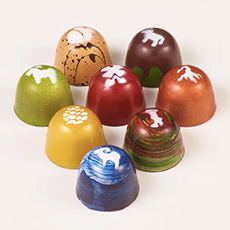
[1] This is one of the eight creations from the Fromage Chocolate Collection, featuring pairings of chocolate ganache and artisanal cheeses in brightly enrobed in different types of chocolate (photos #1# through #9 and #12 © M. Cacao).
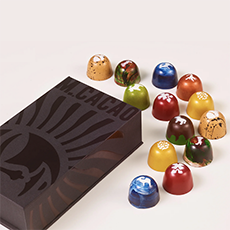
[2] The 16-piece box has two of each flavor.
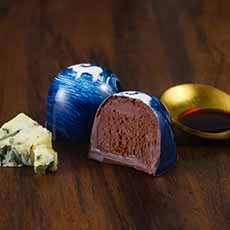
[3] A center of Roquefort cheese and Port wine covered in dark chocolate.
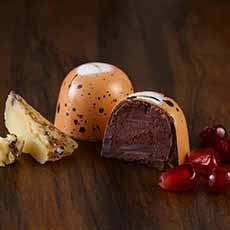
[4] A center of tartuffo (truffle) cheese and pomegranate covered in dark chocolate.
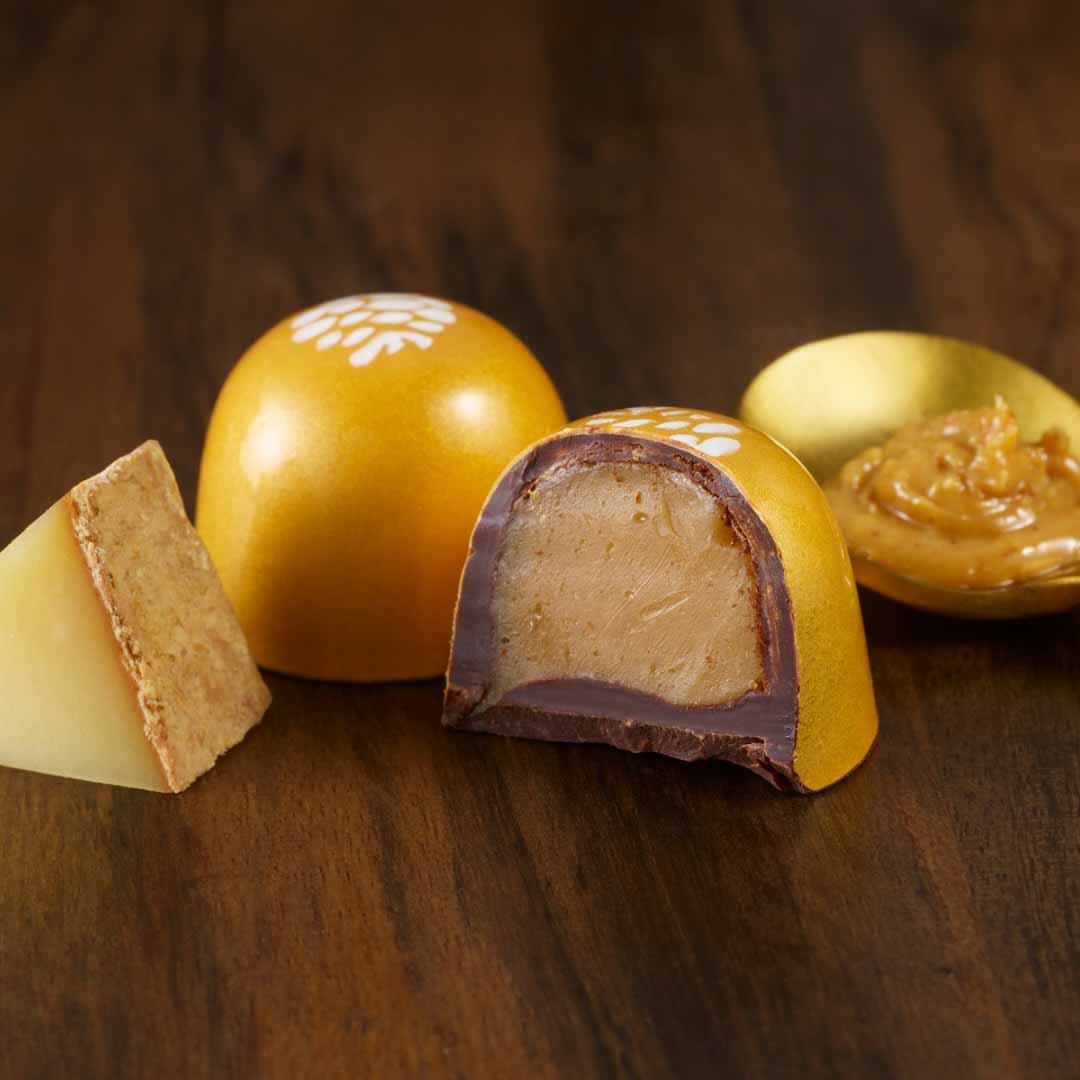
[5] A center of Comté and peanut butter in a cloak of gold chocolate.
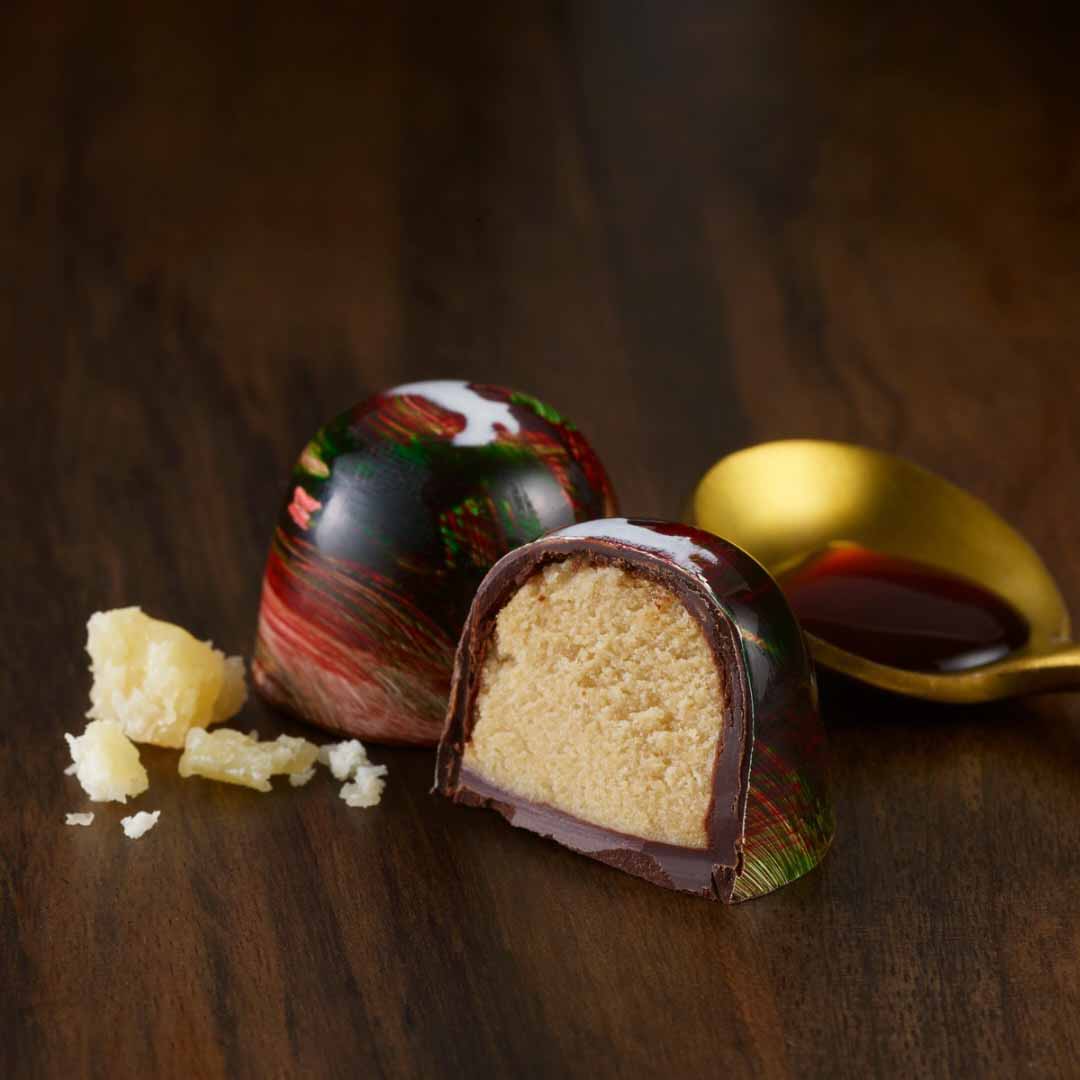
[6] A center of Parmigiano Reggiano cheese and balsamic vinegar enrobed in gold chocolate.
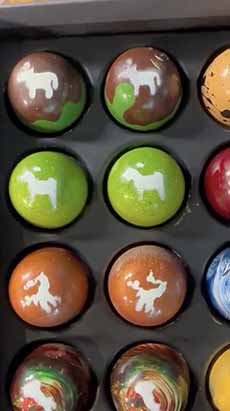
[7] Close up on the bonbons, appropriately decorated with a goat (chèvre), sheep (Roquefort), Italy (Parmigiano Reggiano) and so forth.

[8] A very special option: You can record a video that’s embedded in the lid of the box.
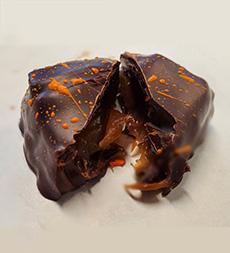
[9] Is this a bonbon, a praline, or a truffle? The answer is in the footnote‡ below.
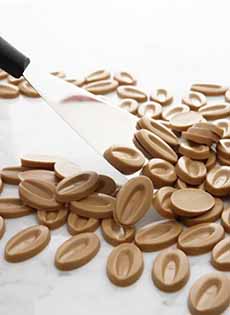
[10] Dulcey chocolate, invented by a French chef and Valrhona Chocolate, is the fourth type of chocolate after dark, milk, and white. The story is in the footnote* below (photo © Valrhona).
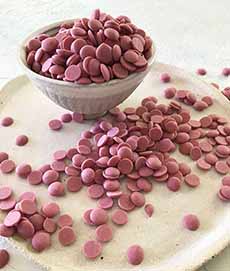
[11] Ruby or rose chocolate, the fifth type of chocolate after dark, milk, white, and blonde/gold/dulcey (photo © Barry Callebaut).
|
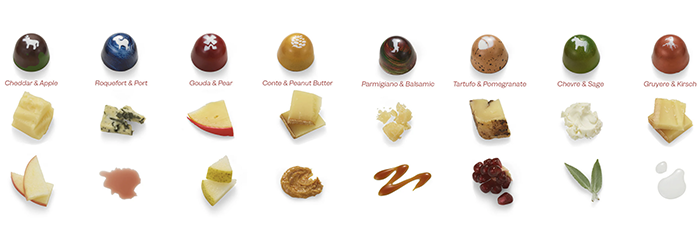
[12] The eight cheese-and-chocolate pairings in the Fromage Chocolate Collection.
SERVE CHOCOLATE & CHEESE PAIRINGS AS A DESSERT COURSE
For a special occasion and a group of foodie friends, you can create your own chocolate and cheese course with fine chocolate bars and fine cheeses.
In addition to the flavors M. Cacao chose, you can:
Pair Dark Chocolate With…
Creamy and mild cheeses: Brie, mascarpone, ricotta, with Moscato d’Asti, Prosecco, or Port.
Nutty and aged cheeses: Aged Gouda, Gruyère, Parmigiano-Reggiano or Pecorino Romano, with Cabernet Sauvignon, Merlot, or oaked Chardonnay..
Tangy and pungent cheeses: blue cheese, Camembert, chèvre, with Sauternes, Tawny or Vintage Port, or Zinfandel.
Pair Milk Chocolate With…
Creamy and mild cheeses: Havarti, mascarpone, or ricotta with late harvest Riesling or moscato.
Mild and tangy cheeses: mild Cheddar, Gorgonzola dolce, with Beaujolais, Lambrusco, or Port.
Nutty cheeses: Comté, Emmental, Gouda, Jarlsberg with Merlot or Cabernet Sauvignon.
Pair White Chocolate With…
White chocolate is sweeter and creamier than dark or milk chocolate, with a rich vanilla and cocoa butter flavor. They need cheeses that have a mild flavor but can stand up to the sweet creaminess.
Fresh cheeses: chevre, mascarpone, or ricotta with Moscato d’Asti, Prosecco, Sauvignon Blanc or Vin Santo
Mild and creamy cheeses: Brie or Havarti with Champagne or other sparkling wine.
Pungent cheeses: a mild blue like Bleu d’Auvergne, Cambozola, Danish Blue, or Gorgonzola Dolce with Port or Zinfandel.
> The different types of chocolate: a photo glossary.
> The different types of cheese: a photo glossary.
> The history of chocolate.
> The history of cheese.
________________
*Gold chocolate, also called blonde chocolate and dulcey chocolate, was a happy accident. The famous French pastry chef Frédéric Bau was in Japan for a chocolate trade fair. He let his white chocolate melt in a bain-marie a bit too long, which gave it a beautiful blonde hue and flavor and aroma notes of toasted shortbread and caramelized milk. Frédéric Bau had discovered a fourth color for chocolate. It took Valrhona eight years of research and development to develop the final Blond Dulcey recipe, officially releasing it in 2012 as the first “blonde chocolate.”
The name Dulcey comes from Frédéric Bau, who named it after the French word “dulce,” meaning sweet or sugary.
His creation made blonde/dulce/gold chocolate the fourth variety, after dark, milk, and white chocolates. The fifth variety available today, ruby/rose chocolate, was introduced in 2017 by Barry Callebaut. It was developed from a special variety of ruby cocoa beans and has a natural pink color with a fruity, berry-like flavor.
†Bonbon or bon bon is French for “good, good.” The full French term is bonbon de chocolat. They are also called chocolats fourrés assortis, assorted filled chocolates. A hard shell of chocolate is filled with a variety of centers.
Other countries use other words, creating confusion. The term is praline in Belgium—not to be confused with America’s southern pecan pralines, while in France, a praline is a caramelized almond.
To add to the confusion, the French word truffe (truffle), which refers to balls of ganache rolled in cocoa powder or other coatings (so-named because it resembles the black truffle fungus). In the U.S., the term is used by some to describe filled hard shells—i.e., bonbons and pralines. Unfortunately, there is no governing body to standardize terminology.
‡As cheese ages, it tastes saltier. As it loses moisture, which means the same amount of salt is distributed in a smaller volume. As the protein and fat break down the perception of saltiness as umami-rich compounds, like amino acid In long-aged cheeses like Parmigiano, Gouda, or Cheddar, tiny white calcium lactate crystals called tyrosines form. They add a crunchy texture and an extra boost of saltiness.
There are exceptions to these rules. For example, Emmental can be aged for a long time without developing more saltiness due to its mild fermentation process.
CHECK OUT WHAT’S HAPPENING ON OUR HOME PAGE, THENIBBLE.COM.
|












